Unearthing Scientific History through Art: New Insights from the Archives of Lewis David von Schweinitz, the “Father of North American Mycology”
↧
↧
Uncovering Mycological History…One Sketch at a Time
↧
MUDPIE — Online at BHL! Documenting the History of Computers in Museums
 On September 12, 1967 Ralph Axtell, of the Biology Department of Southern Illinois University, called the Smithsonian Institution using the teletype connected to his time-shared computer and asked for a [computer] program for the calculation of standard deviations. The Smithsonian then sent him two computer programs. This demonstrated that, using data communications equipment and telephone lines, “it is fast, practical, and feasible to exchange programs in the BASIC language, written for use by biosystematists, between institutions in the United States." A revolution had begun that would transform museums, research, systematics and science.
The following day Dr. James A. Peters produced the inaugural issue of the MUDPIE (Museum and University Data Program and Information Exchange) Newsletter.
MUDPIE newsletter documents many early events in the adoption of computers and timesharing computing in museums and universities, and was founded and produced by Dr. Peters, the only editor in the newsletter’s publication history. Twenty-six issues of MUDPIE were produced and distributed over a five-year period, between September 1967 and September 1972. All issues are now digitally available at the Biodiversity Heritage Library thanks to the Smithsonian Libraries.
On September 12, 1967 Ralph Axtell, of the Biology Department of Southern Illinois University, called the Smithsonian Institution using the teletype connected to his time-shared computer and asked for a [computer] program for the calculation of standard deviations. The Smithsonian then sent him two computer programs. This demonstrated that, using data communications equipment and telephone lines, “it is fast, practical, and feasible to exchange programs in the BASIC language, written for use by biosystematists, between institutions in the United States." A revolution had begun that would transform museums, research, systematics and science.
The following day Dr. James A. Peters produced the inaugural issue of the MUDPIE (Museum and University Data Program and Information Exchange) Newsletter.
MUDPIE newsletter documents many early events in the adoption of computers and timesharing computing in museums and universities, and was founded and produced by Dr. Peters, the only editor in the newsletter’s publication history. Twenty-six issues of MUDPIE were produced and distributed over a five-year period, between September 1967 and September 1972. All issues are now digitally available at the Biodiversity Heritage Library thanks to the Smithsonian Libraries.
↧
BHL Welcomes the Auckland War Memorial Museum Tāmaki Paenga Hira
 The Biodiversity Heritage Library is pleased to welcome the Auckland War Memorial Museum Tāmaki Paenga Hira as a new Affiliate. Auckland Museum is BHL’s first partner in Aotearoa New Zealand.
Tracing its roots back to 1852, Auckland Museum was one of New Zealand’s first museums and is regarded as one of the finest in the Southern Hemisphere. Renowned for its collection of Māori and Pacific treasures along with significant natural history resources, the Museum tells the story of New Zealand, its place in the Pacific and its people. It is also a war memorial for the province of Auckland.
The Museum is home to one of New Zealand’s finest heritage research libraries. Serving the Museum since 1867, the Library’s key focus is caring for and providing access to the Museum's Documentary Heritage collections, including manuscripts, photographs and artwork, ephemera, oral histories, rare books, and serials. The Library's collections have an overarching focus on the Auckland province and te ao Māori (the Māori world), and its natural history collection strengths include botany, and academic and general-interest works related to the natural sciences.
The Biodiversity Heritage Library is pleased to welcome the Auckland War Memorial Museum Tāmaki Paenga Hira as a new Affiliate. Auckland Museum is BHL’s first partner in Aotearoa New Zealand.
Tracing its roots back to 1852, Auckland Museum was one of New Zealand’s first museums and is regarded as one of the finest in the Southern Hemisphere. Renowned for its collection of Māori and Pacific treasures along with significant natural history resources, the Museum tells the story of New Zealand, its place in the Pacific and its people. It is also a war memorial for the province of Auckland.
The Museum is home to one of New Zealand’s finest heritage research libraries. Serving the Museum since 1867, the Library’s key focus is caring for and providing access to the Museum's Documentary Heritage collections, including manuscripts, photographs and artwork, ephemera, oral histories, rare books, and serials. The Library's collections have an overarching focus on the Auckland province and te ao Māori (the Māori world), and its natural history collection strengths include botany, and academic and general-interest works related to the natural sciences.
↧
BHL at the GBIF 25th Governing Board Annual Meeting
 As Chair of BHL, I had the privilege of attending the 25th Meeting of the GBIF Global Governing Board convened in Kilkenny, Ireland, 15-18 October 2018. I represent BHL in its capacity as an Associate Participant in GBIF at the governing board meeting. BHL has been a participant since 2014.
The Global Biodiversity Information Facility (GBIF) operates through a network of global nodes to develop and maintain an open data infrastructure for sharing digital biodiversity data.
As Chair of BHL, I had the privilege of attending the 25th Meeting of the GBIF Global Governing Board convened in Kilkenny, Ireland, 15-18 October 2018. I represent BHL in its capacity as an Associate Participant in GBIF at the governing board meeting. BHL has been a participant since 2014.
The Global Biodiversity Information Facility (GBIF) operates through a network of global nodes to develop and maintain an open data infrastructure for sharing digital biodiversity data.
↧
↧
Labillardière and the Botany of the Levant
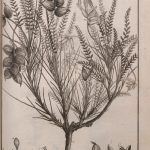 At the end of the 18th century, French naturalist Jacques-Julien Houtou de Labillardière spent two years exploring and collecting plants in the Levant. The expedition ultimately resulted in the publication of a beautifully-illustrated work on the botany of the region, Icones plantarum Syriæ rariorum (“Rare Syrian Plant Images”).
At the end of the 18th century, French naturalist Jacques-Julien Houtou de Labillardière spent two years exploring and collecting plants in the Levant. The expedition ultimately resulted in the publication of a beautifully-illustrated work on the botany of the region, Icones plantarum Syriæ rariorum (“Rare Syrian Plant Images”).
↧
A Book’s Eight Year Journey to the Biodiversity Heritage Library: Fulfilling a Researcher’s Digitization Request and Advancing Science
 As an early work in the history of Linnaean taxonomy, Beredeneerde catalogus van eene, by uitstek fraaye en weergaalooze verzameling, zoo van inlandsche als uitheemsche vogelen, viervoetige en gekorvene dieren (i.e. Vroeg’s Catalogue, 1764) by Adrian Vroeg is the source of dozens of new species of birds. Published just six years after the 10th edition of Linnaeus’ Systema Naturae — considered the starting point of zoological nomenclature — the work is extremely rare, with only a handful of copies known to exist worldwide.
Because of the work’s age and rarity, first-hand access to the title has been difficult, and many researchers have had to rely on secondary sources for Vroeg’s names, which may have introduced errors or even overlooked the priority of a name established by Vroeg.
“It is absolutely rare that the scientific community gets access to such an early work in which new names were established after 1758,” explains Dr. Francisco Welter-Schultes of the Zoological Institute of Göttingen University in Germany. “Imagine being able to finally view an original spelling of a name that might not have been verified for more than 100 years. Generations of scientists never reliably saw the correct spellings of these names.”
As an early work in the history of Linnaean taxonomy, Beredeneerde catalogus van eene, by uitstek fraaye en weergaalooze verzameling, zoo van inlandsche als uitheemsche vogelen, viervoetige en gekorvene dieren (i.e. Vroeg’s Catalogue, 1764) by Adrian Vroeg is the source of dozens of new species of birds. Published just six years after the 10th edition of Linnaeus’ Systema Naturae — considered the starting point of zoological nomenclature — the work is extremely rare, with only a handful of copies known to exist worldwide.
Because of the work’s age and rarity, first-hand access to the title has been difficult, and many researchers have had to rely on secondary sources for Vroeg’s names, which may have introduced errors or even overlooked the priority of a name established by Vroeg.
“It is absolutely rare that the scientific community gets access to such an early work in which new names were established after 1758,” explains Dr. Francisco Welter-Schultes of the Zoological Institute of Göttingen University in Germany. “Imagine being able to finally view an original spelling of a name that might not have been verified for more than 100 years. Generations of scientists never reliably saw the correct spellings of these names.”
↧
The Orchidaceous Plants of Franz Bauer and John Lindley
 Two of the most important early contributors to our understanding of orchids were the artist Franz Bauer (1758-1840) and the English botanist and gardener John Lindley (1799-1865), who was to become known as the “father of modern orchidology”. The publication of the Illustrations of Orchidaceous Plants [from sketches prepared between 1792 and 1832] between 1830 and 1838 combined Bauer’s great skill and Lindley’s knowledge and industriousness to produce an invaluable artistic and scientific work. The Natural History Museum, London (NHM) has recently uploaded their copy of this volume to sit alongside the Missouri Botanical Gardens’ own volume.
Two of the most important early contributors to our understanding of orchids were the artist Franz Bauer (1758-1840) and the English botanist and gardener John Lindley (1799-1865), who was to become known as the “father of modern orchidology”. The publication of the Illustrations of Orchidaceous Plants [from sketches prepared between 1792 and 1832] between 1830 and 1838 combined Bauer’s great skill and Lindley’s knowledge and industriousness to produce an invaluable artistic and scientific work. The Natural History Museum, London (NHM) has recently uploaded their copy of this volume to sit alongside the Missouri Botanical Gardens’ own volume.
↧
BHL and WikiCite 2018
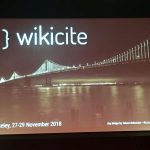 In November 2018, Diane Shaw, Katie Mika and Siobhan Leachman attended WikiCite 2018 in Berkeley, CA. WikiCite is a Wikimedia initiative that aims to develop a database of open citations and linked bibliographic data.
Katie, a former BHL National Digital Stewardship Resident from Harvard’s Museum of Comparative Zoology, and Siobhan, a citizen scientist and linked open data champion from New Zealand who has been a devoted transcriber of natural history materials in the Smithsonian Transcription Center, gave a talk on WikiCite and the Biodiversity Heritage Library. They described some of the unique challenges for heritage literature and metadata, and demonstrated how open access citations, images, and details gleaned from BHL and other open natural history digital repositories are applied to Wikimedia Foundation projects to support essential documentation of scientists, literature, and rare and endemic species.
In November 2018, Diane Shaw, Katie Mika and Siobhan Leachman attended WikiCite 2018 in Berkeley, CA. WikiCite is a Wikimedia initiative that aims to develop a database of open citations and linked bibliographic data.
Katie, a former BHL National Digital Stewardship Resident from Harvard’s Museum of Comparative Zoology, and Siobhan, a citizen scientist and linked open data champion from New Zealand who has been a devoted transcriber of natural history materials in the Smithsonian Transcription Center, gave a talk on WikiCite and the Biodiversity Heritage Library. They described some of the unique challenges for heritage literature and metadata, and demonstrated how open access citations, images, and details gleaned from BHL and other open natural history digital repositories are applied to Wikimedia Foundation projects to support essential documentation of scientists, literature, and rare and endemic species.
↧
↧
Join us for a Women in Natural History Wikipedia Editing Workshop on 13 March!
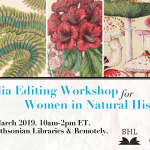 Help us enhance information in Wikipedia about women in natural history during our Wikipedia Editing Workshop on 13 March in celebration of Women’s History Month!
In collaboration with Smithsonian Libraries and with support from Wikimedia DC, we’ll be hosting a Wikipedia Editing Workshop from 10am-2pm ET on 13 March to improve and create Wikipedia articles related to women in natural history. The workshop will be hosted by the Smithsonian Libraries in the National Museum of Natural History Library. There will also be virtual participation options. Registration is required.
Help us enhance information in Wikipedia about women in natural history during our Wikipedia Editing Workshop on 13 March in celebration of Women’s History Month!
In collaboration with Smithsonian Libraries and with support from Wikimedia DC, we’ll be hosting a Wikipedia Editing Workshop from 10am-2pm ET on 13 March to improve and create Wikipedia articles related to women in natural history. The workshop will be hosted by the Smithsonian Libraries in the National Museum of Natural History Library. There will also be virtual participation options. Registration is required.
↧
Vanity and BHL: Examining Extinction and Rediscovery through Art
 Vanity, an art installation by Joseph Gregory Rossano created for and with the support of the Museum of Glass (MOG) in Tacoma, Washington, tells the story of eleven species and subspecies, presumed extinct, presented through the lens of humanity’s role in their demise. The exhibition features historical accounts detailing each species’ “discovery” (collection date, type locality, collector, scientific illustrations, etc.), humanity’s role in its extinction, and the year it was declared “Extinct”. To produce these species tales, Rossano collaborated with Sandra I. Berríos-Torres, MD. Berríos-Torres served as author of the 11 historical accounts and as Editorial Director of the exhibition catalogue, on behalf of Joseph Gregory Rossano.
The Biodiversity Heritage Library was a crucial resource for Berríos-Torres. Consulting dozens of publications in BHL while conducting research for Vanity, she ultimately cited 16 of them in the historical accounts that were incorporated into the exhibition and catalogue.
Vanity, an art installation by Joseph Gregory Rossano created for and with the support of the Museum of Glass (MOG) in Tacoma, Washington, tells the story of eleven species and subspecies, presumed extinct, presented through the lens of humanity’s role in their demise. The exhibition features historical accounts detailing each species’ “discovery” (collection date, type locality, collector, scientific illustrations, etc.), humanity’s role in its extinction, and the year it was declared “Extinct”. To produce these species tales, Rossano collaborated with Sandra I. Berríos-Torres, MD. Berríos-Torres served as author of the 11 historical accounts and as Editorial Director of the exhibition catalogue, on behalf of Joseph Gregory Rossano.
The Biodiversity Heritage Library was a crucial resource for Berríos-Torres. Consulting dozens of publications in BHL while conducting research for Vanity, she ultimately cited 16 of them in the historical accounts that were incorporated into the exhibition and catalogue.
↧
Coming This March! Her Natural History: A Celebration of Women in Natural History
 This Women's History Month, we invite you to join us in celebrating women in natural history as part of an international social media campaign produced in collaboration with our partners — Her Natural History: A Celebration of Women in Natural History.
Through social media and blog posts, interactive programming and citizen science opportunities, Her Natural History aims to increase awareness of and information about women in the biodiversity sciences.
The campaign will kick-off with an all-day social media blitz on Friday, 8 March 2019 (International Women's Day) and continue throughout the month with additional posts and programming, including a Wikipedia Editing Workshop on 13 March. #HerNaturalHistory is also the @iglibraries #LibrariesOfInstagram challenge topic for March.
This Women's History Month, we invite you to join us in celebrating women in natural history as part of an international social media campaign produced in collaboration with our partners — Her Natural History: A Celebration of Women in Natural History.
Through social media and blog posts, interactive programming and citizen science opportunities, Her Natural History aims to increase awareness of and information about women in the biodiversity sciences.
The campaign will kick-off with an all-day social media blitz on Friday, 8 March 2019 (International Women's Day) and continue throughout the month with additional posts and programming, including a Wikipedia Editing Workshop on 13 March. #HerNaturalHistory is also the @iglibraries #LibrariesOfInstagram challenge topic for March.
↧
Rediscovering Millipedes with the Biodiversity Heritage Library
 Like many taxonomists, I like to group things together and sort them: specimens into species, species into genera, references into bibliographies, images into galleries. The Biodiversity Heritage Library has been a powerful enabler for me as a grouper-sorter.
Fifteen or so years ago, a literature search still required at least one long and expensive trip from my home town in regional Tasmania to an academic library in Hobart (Tasmania's capital city), or in Melbourne or Canberra on the Australian mainland. Reams of paper were used to make photocopies of key references that I could take home with me. Weeks were spent waiting for additional photocopies to arrive through inter-library loans. When I finally had all the relevant older references, I could do my revisionary taxonomic work.
Then BHL appeared.
For the past 10 years, almost all the older literature I need to see has been accessed through BHL — quickly, cheaply and paperlessly.
Like many taxonomists, I like to group things together and sort them: specimens into species, species into genera, references into bibliographies, images into galleries. The Biodiversity Heritage Library has been a powerful enabler for me as a grouper-sorter.
Fifteen or so years ago, a literature search still required at least one long and expensive trip from my home town in regional Tasmania to an academic library in Hobart (Tasmania's capital city), or in Melbourne or Canberra on the Australian mainland. Reams of paper were used to make photocopies of key references that I could take home with me. Weeks were spent waiting for additional photocopies to arrive through inter-library loans. When I finally had all the relevant older references, I could do my revisionary taxonomic work.
Then BHL appeared.
For the past 10 years, almost all the older literature I need to see has been accessed through BHL — quickly, cheaply and paperlessly.
↧
↧
Galen Clark: The Guardian of Yosemite
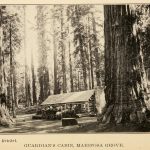 When Galen Clark’s The Big Trees of California, their History and Characteristics, was published, in 1907, he was 93 years old. It had been 50 years since he first came to live in the Mariposa Grove in Yosemite Valley. He had spent most of those years in the midst of the giant sequoias, serving as a guide and educator, and fighting for the protection of these natural wonders.
The noted naturalist and conservationist John Muir met Galen Clark on his first visit to Yosemite, and later, in his writing on The Yosemite, called him "the best mountaineer I ever met, and one or the kindest and most amiable of all my mountain friends." Along with Muir, Clark was instrumental in Yosemite's preservation and development as a national park.
When Galen Clark’s The Big Trees of California, their History and Characteristics, was published, in 1907, he was 93 years old. It had been 50 years since he first came to live in the Mariposa Grove in Yosemite Valley. He had spent most of those years in the midst of the giant sequoias, serving as a guide and educator, and fighting for the protection of these natural wonders.
The noted naturalist and conservationist John Muir met Galen Clark on his first visit to Yosemite, and later, in his writing on The Yosemite, called him "the best mountaineer I ever met, and one or the kindest and most amiable of all my mountain friends." Along with Muir, Clark was instrumental in Yosemite's preservation and development as a national park.
↧
A Fond Farewell to Carolyn Sheffield (BHL Program Manager)
 The Biodiversity Heritage Library's loss is the gain of the University of Maryland, Baltimore County, Albin O. Kuhn Library & Gallery. Carolyn Sheffield, BHL Program Manager, will be taking on a newly developed position as Associate Director, Library Technology and Digital Strategies effective March 4, 2019.
The Biodiversity Heritage Library's loss is the gain of the University of Maryland, Baltimore County, Albin O. Kuhn Library & Gallery. Carolyn Sheffield, BHL Program Manager, will be taking on a newly developed position as Associate Director, Library Technology and Digital Strategies effective March 4, 2019.
↧
Valentina Ly, Digital Content Intern
 As a new Master of Library and Information Studies graduate, I was looking for opportunities to gain more library experience, especially with regard to cataloguing and metadata. An internet search led me to the many intern opportunities available at Smithsonian Libraries. The Digital Content Intern position at the Biodiversity Heritage Library was a perfect fit for me. It was a virtual position, allowing me the flexibility to stay in Toronto, Canada and maintain a full-time job at a hospital. I completed my entire master’s through an online program from a Canadian university while living in Melbourne, Australia, so I was familiar working at a distance, independently, and using digital mediums to learn and connect with others.
As a new Master of Library and Information Studies graduate, I was looking for opportunities to gain more library experience, especially with regard to cataloguing and metadata. An internet search led me to the many intern opportunities available at Smithsonian Libraries. The Digital Content Intern position at the Biodiversity Heritage Library was a perfect fit for me. It was a virtual position, allowing me the flexibility to stay in Toronto, Canada and maintain a full-time job at a hospital. I completed my entire master’s through an online program from a Canadian university while living in Melbourne, Australia, so I was familiar working at a distance, independently, and using digital mediums to learn and connect with others.
↧
Happy Women’s History Month! Join Us For #HerNaturalHistory Starting 8 March 2019
 March is Women's History Month, and we're celebrating with an international social media campaign produced in collaboration with our partners highlighting women and their contributions to natural history — Her Natural History: A Celebration of Women in Natural History.
Kicking-off with an all-day social media blitz on Friday, 8 March 2019 (International Women's Day) and continuing throughout the month, Her Natural History aims to increase awareness of and information about women in the biodiversity sciences.
March is Women's History Month, and we're celebrating with an international social media campaign produced in collaboration with our partners highlighting women and their contributions to natural history — Her Natural History: A Celebration of Women in Natural History.
Kicking-off with an all-day social media blitz on Friday, 8 March 2019 (International Women's Day) and continuing throughout the month, Her Natural History aims to increase awareness of and information about women in the biodiversity sciences.
↧
↧
Her Natural History: A Celebration of Women in Natural History
 Women have made remarkable contributions to biodiversity research. From collecting specimens and serving as scientific illustrators to conducting and publishing research, authoring natural history books, and more, women have overcome many social and cultural obstacles and gender barriers in what has historically been a male-dominated field to help further our understanding of the natural world. While the work of many remained unacknowledged or under-appreciated during their lifetimes, mounting initiatives to encourage and support women in the sciences have facilitated a growing recognition of the achievements of women in natural history — both past and present.
This Women's History Month, we are excited to recognize and celebrate the contributions of women to natural history through an international social media campaign produced in collaboration with our partners — Her Natural History: A Celebration of Women in Natural History.
Kicking-off with an all-day social media blitz today, 8 March 2019 (International Women's Day,) and continuing throughout the month, Her Natural History aims to increase awareness of and information about women in the biodiversity sciences.
Women have made remarkable contributions to biodiversity research. From collecting specimens and serving as scientific illustrators to conducting and publishing research, authoring natural history books, and more, women have overcome many social and cultural obstacles and gender barriers in what has historically been a male-dominated field to help further our understanding of the natural world. While the work of many remained unacknowledged or under-appreciated during their lifetimes, mounting initiatives to encourage and support women in the sciences have facilitated a growing recognition of the achievements of women in natural history — both past and present.
This Women's History Month, we are excited to recognize and celebrate the contributions of women to natural history through an international social media campaign produced in collaboration with our partners — Her Natural History: A Celebration of Women in Natural History.
Kicking-off with an all-day social media blitz today, 8 March 2019 (International Women's Day,) and continuing throughout the month, Her Natural History aims to increase awareness of and information about women in the biodiversity sciences.
↧
Transcribe Field Notes by Female Naturalists with the #HerNaturalHistory Transcription Challenge
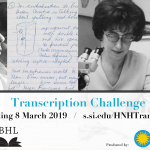 Looking for a challenge? The Smithsonian Institution Archives and the Smithsonian Transcription Center are teaming up for a #HerNaturalHistory-themed transcription challenge. Starting today (8 March), help a team of #volunpeers transcribe field notes from conservation biologist Devra Kleiman and botanist Cleofé Calderon. Dive into observations of golden lion tamarins with Kleiman, who worked at Smithsonian’s National Zoological Park from 1972 to 2001. And head to South America with Calderón to collect grasses for Smithsonian’s Department of Botany.
Looking for a challenge? The Smithsonian Institution Archives and the Smithsonian Transcription Center are teaming up for a #HerNaturalHistory-themed transcription challenge. Starting today (8 March), help a team of #volunpeers transcribe field notes from conservation biologist Devra Kleiman and botanist Cleofé Calderon. Dive into observations of golden lion tamarins with Kleiman, who worked at Smithsonian’s National Zoological Park from 1972 to 2001. And head to South America with Calderón to collect grasses for Smithsonian’s Department of Botany.
↧
Isabella in Hawaii: The Adventures of an Amateur Botanist in the 1860s
 How does a young woman create the most important record of Hawaiian flowers in the nineteenth century? Who helps her identify plants and find a London publisher? Why does she leave New Zealand for Niihau, the Forbidden Island? Thanks to a magnificent book in the Rare Book Collection of the Chicago Botanic Garden Library (and a little research), we can answer these questions.
With 44 delightful chromolithographed plates, Indigenous Flowers of the Hawaiian Islands is no ordinary book. Its illustrations introduced the world to an exotic, endemic, and vanishing flora. Indigenous Flowers provides a marker to measure the impact of humans on the fragile ecosystem of two Hawaiian islands, yet another signal of the Anthropocene epoch. Isabella McHutcheson Sinclair (1840–90) was probably the most unexpected ambassador for plant conservation. Her breadth of botanical experiences in the Pacific, in both New Zealand and the Sandwich Islands (better known today as Hawaii), gave her a particular vision to recognize the effects of humans on local flora and fauna.
How does a young woman create the most important record of Hawaiian flowers in the nineteenth century? Who helps her identify plants and find a London publisher? Why does she leave New Zealand for Niihau, the Forbidden Island? Thanks to a magnificent book in the Rare Book Collection of the Chicago Botanic Garden Library (and a little research), we can answer these questions.
With 44 delightful chromolithographed plates, Indigenous Flowers of the Hawaiian Islands is no ordinary book. Its illustrations introduced the world to an exotic, endemic, and vanishing flora. Indigenous Flowers provides a marker to measure the impact of humans on the fragile ecosystem of two Hawaiian islands, yet another signal of the Anthropocene epoch. Isabella McHutcheson Sinclair (1840–90) was probably the most unexpected ambassador for plant conservation. Her breadth of botanical experiences in the Pacific, in both New Zealand and the Sandwich Islands (better known today as Hawaii), gave her a particular vision to recognize the effects of humans on local flora and fauna.
↧
More Pages to Explore .....








